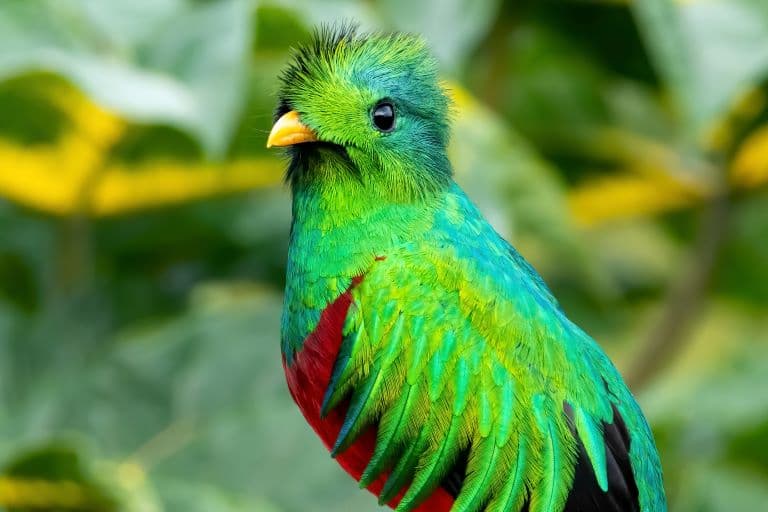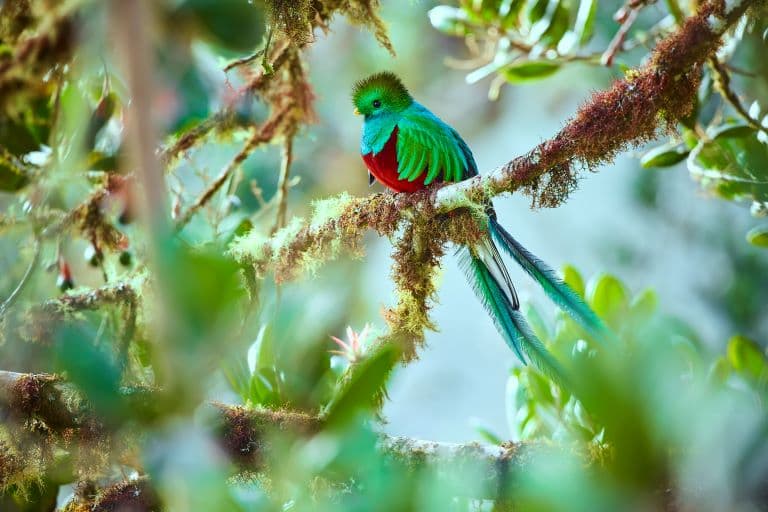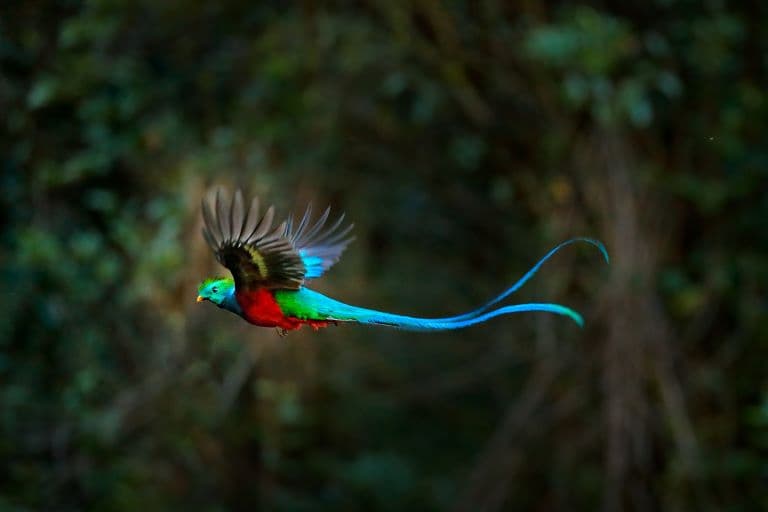Quetzal Profile
Quetzals are a small group of spectacularly coloured, fruit-eating tropical birds of the Trogon family, which are found only in central and south America. 1
They inhabit tropical rainforests and cloud forests and can be found throughout Central America from Mexico to Panama, with notable populations residing in the protected forests of Costa Rica. They prefer highland forests, at altitudes between 4000 and 10000 feet above sea level, where the air is cool and very humid.
Quetzals spend much of their time high up in the treetops: resting, foraging and feeding. They live in holes close to the tops of trees in the rainforest canopy, which they burrow out themselves using their beaks.
They are also known to use abandoned woodpecker nests as homes. Quetzals are crepuscular in nature, being most active in the morning and at dusk when there is plenty of mist among the trees. They are elusive and rarely seen –it is therefore considered very special to catch a glimpse of a quetzal.
All species of quetzal are incredibly vibrantly coloured. They are a shimmering green/blue on their back and wings, with darker wings and green/blue tail feathers. Males have a vibrant red underside and a golden-green crest on their heads.
Females are duller in colour but still extremely beautiful. The iridescent colours of the quetzal are practical as well as beautiful, since they offer effective camouflage in the shiny, wet leaves of humid rainforests. 2

Quetzal Facts Overview
| Habitat: | High, humid tropical rainforests/cloud forests |
| Location: | Central and South America |
| Lifespan: | 20-25 years |
| Size: | 35-40cm (14-16in) |
| Weight: | 200-225g (7-8oz) |
| Color: | Blue, green, red, gold |
| Diet: | Omnivore: fruits, berries, insects, lizards |
| Predators: | Kinkajou, squirrels, birds of prey |
| No. of Species: | 6 |
| Conservation Status: | Near threatened/threatened |
The tail feathers of males grow longer during mating season. After mating, the pair will take turns incubating two to three eggs inside their tree trunk home – even though the male tail feathers are so long that they often protrude out of the nest!
Chicks can fly at around 3 weeks old and will then move on to find their own territory not long after that, although they do tend to stay close to the parent birds for the first few years. Males do not grow their tail feathers long until they reach sexual maturity at around 3 years old. 3 4
Interesting Quetzal Facts
1. Quetzals have extremely long tail feathers
The tail feathers of the male quetzal can be up to 1m long, making the quetzal one of the longest birds.
2. Quetzals were considered sacred by the Aztec and Maya peoples
The resplendent quetzal is most notably a sacred symbol in the ancient Aztec and Mayan cultures. The brightly coloured birds are associated with Quetzalcoatl, the snake god, and are considered to be symbols of goodness and light.
Priests and nobility would wear headdresses made from the long tail feathers; these were procured by trapping the quetzal, plucking the tail feathers and releasing the live bird, since it was considered a crime to kill a quetzal. 5
Today, the resplendent quetzal is the national emblem and the monetary unit of Guatamala.

3. Quetzals are regarded as some of the most beautiful birds in the world
This is mainly down to the incredibly long and colourful plumage in the tails of male quetzals.
4. Quetzals are not good at flying!
Although it seems strange for a forest-dwelling bird to lack ease of flight, quetzals are actually not particularly accomplished fliers, and instead tend to hop or jump from branch to branch. Their habit of staying in the trees means that they are an easy target for predators.

5. Quetzals have unique feet
Not seen anywhere else in the avian kingdom, quetzals have two toes facing forward and two toes facing back, which enables them to grip firmly on to branches high up in the trees. Their foot structure means they are not well adapted to walking on the ground, and they therefore spend very little time on the forest floor, instead remaining high up in the trees to feed and roost.
6. The quetzal call is very distinctive
The sound of the quetzal call is almost as distinct as its bright plumage, and is very soft and deep. They have various different calls, including an unusual whining sound made during mating season, and a whistle-like call that is made at dawn and dusk.
7. Quetzals play the role of forest ‘gardener’
Although they also eat lizards and insects, quetzals mostly consume fruit: mainly small fruits of the avocado family. They will swallow the fruit whole and then regurgitate the pips, or excrete the seeds – subsequently helping to disperse trees around the forest.
8. Quetzals are monogamous birds
Although quetzals are generally solitary creatures, once these beautiful birds have found their mate, they will stay together for the duration of the reproductive period. Both will contribute to the incubation of eggs and the rearing of the young until they have flown the nest.
9. The biggest threat to quetzals is habitat loss
Due to deforestation and human-caused degradation, the different quetzal species are threatened by the loss of their tropical rainforest homes. In some areas, particularly the cloud forests of Costa Rica, there are protected areas where the quetzal can thrive in their native home, and avid birdwatchers from around the globe can enjoy unique birdwatching opportunities.
10. Through their beauty, quetzals are helping to conserve forests
Since catching a glimpse of the incredible beauty of birds such as the resplendent quetzal is a draw for many nature lovers and bird watchers, the increasing number of protected areas of forest are supporting habitats for these incredible birds. Their beauty is therefore somehow also their saving grace! 6 7
Quetzal Fact-File Summary
Scientific Classification
| Kingdom | Animalia |
| Phylum | Chordata |
| Class | Aves |
| Order | Trogoniformes |
| Family | Trogonidae |
| Genus | Pharomachrus |
| Scientific Name | Euptilotis |
Fact Sources & References
- John P. Rafferty (1998), “Quetzal”, Britannica.
- “Resplendent Quetzal”, National Geographic.
- “Resplendent Quetzal”, American Bird Conservacy.
- “Resplendent Quetzal”, Florida Museum.
- “Golden-headed Quetzal”, ABC Birds.
- “Golden-headed Quetzal (Pharomachrus auriceps)”, Peru Aves.
- “Golden-headed Quetzal (auriceps)”, Avibase.
